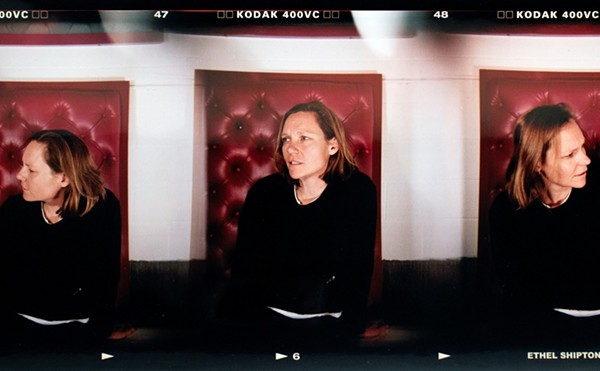Jesse Amado’s new show at SalaDiaz is some strong medicine. Most immediately eye-catching in the gallery’s front exhibition room is a neon sign installation, whose elegant white tubes spell “MISSION ACCOMPLISHED.” You no doubt recognize the phrase from the banner backgrounding President Bush’s now-infamous “aircraft carrier” speech of 2003, but the only letters in Amado’s neon phrase that light up, at intervals, are “I L-I-E-D.” Amado’s between-the-lines “confession” expresses a flash of real outrage. As Aeschylus said, the first casualty of war is truth.
Across from the white neon missive hangs an installation consisting of two canvases painted black, a carpenter’s level, and a gorgeous and mournful graffito of funereal black fringe trailing across the wooden floor, spelling in feminine cursive the phrase “no more.” The top painting is adorned solely by what appears to be a heraldic sew-on patch of a human skull. Where the “white” installation flashes outrage, the “black” one seems intent on sorrow.
In SalaDiaz’s second room, Amado ropes the Iraq War together with Southern and Western history. Physically. A heap of rough coiled ropes dominating one corner at first suggests something nautical, until the pile resolves itself into carefully tied nooses, one of which clutches a small white plaster head of a Hellenic lady. Helen of Troy, perhaps, the WMD of the Iliad? Facing this is a waist-high mirrored obelisk upon which is draped another, larger-gauge noose of iridescent fawn-colored cord.
Small circular mirrors mounted on each wall are at roughly eye level. One of these, on the far side of the room, bears the following legend, written in black felt-tip pen: “A button spotted outside the Texan Republican convention asked; ‘If Obama is president … will we still call it the white house?’” Adjacent to this are what appear to be three printout scans from a book, two showing trees, one showing an enormous tree’s shadow. On the uppermost of these, best visible if standing to its right and squinting against the overhead light, an eerie roll call is block-written in silver ink, listing various hate groups and their Texas hometowns — for example, “BLOOD AND HONOR, KU KLUX CLAN, RICHARDSON, TX.” A meticulously rendered noose-tying illustration adorns another of the printouts, tying up the lynching imagery.
Then there’s The Book. Though it’s placed carefully upon a podium in the front room, I’d managed to pass it by on my first circuit through the gallery. It’s entitled War Surgery in Afghanistan and Iraq: A Series of Cases, 2003-2007. Bookmarks hold the places of graphic surgical procedures on war victims, including facial reconstruction and a premature delivery of a wounded newborn by a mother who’d been shot in the abdomen. It functioned as the last artwork I perused, and I can’t help wondering how different my experience of Amado’s work would have been had I seen it earlier. Surely Amado means to jar us — but in retrospect, I’m glad I absorbed some of the riveting artwork before processing the visceral shock of what now hovers in my mind’s eye as both haunting and, oddly, superfluous.
VISUAL ART
Jesse Amado: Fringe, Coils, a Demon and a Small Political Allegory
2-6pm Thu-Sat
Through Oct 5
Free
SalaDiaz
517 Stieren
(210) 852-4492















